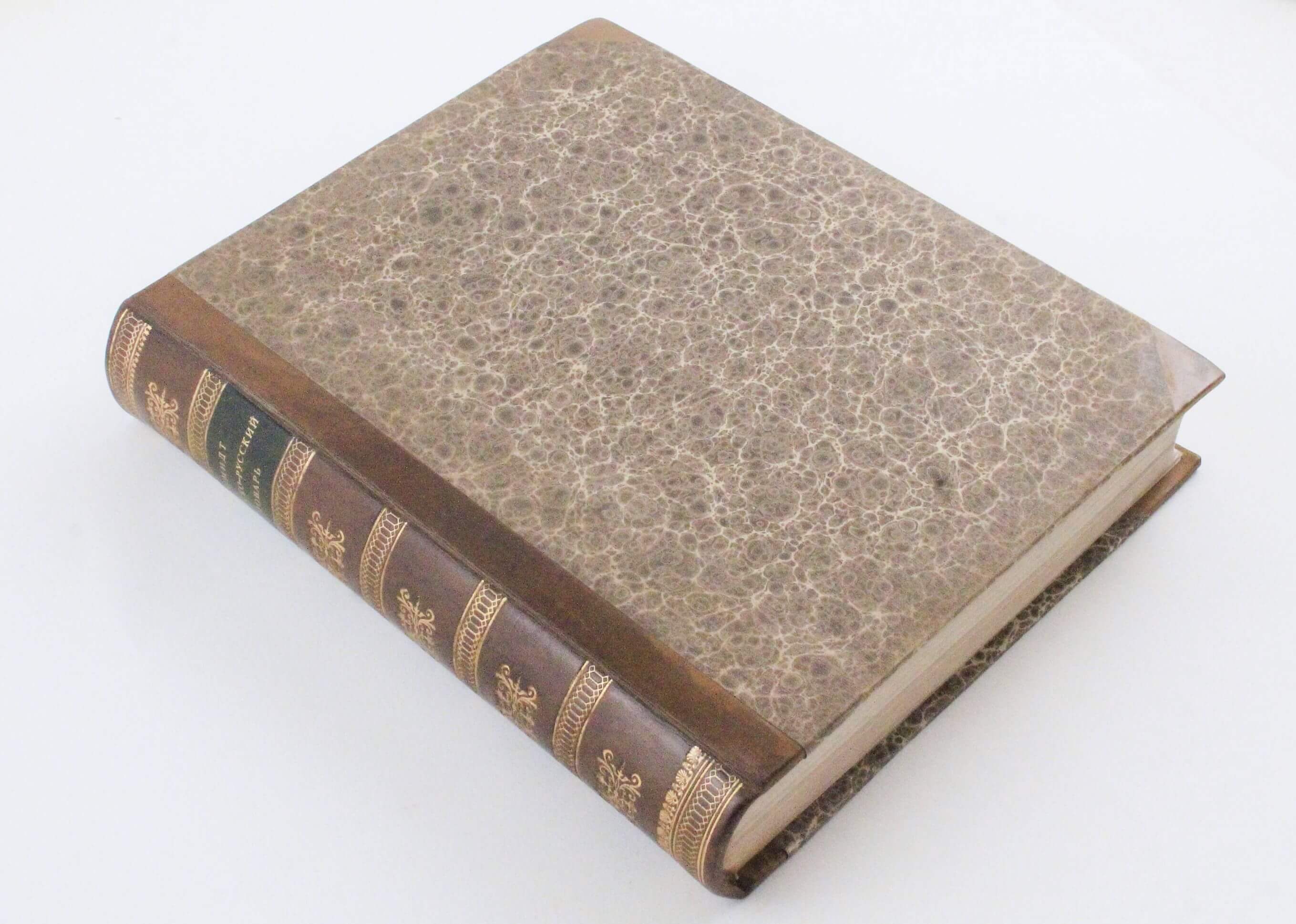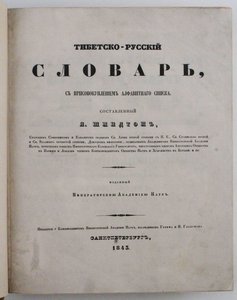


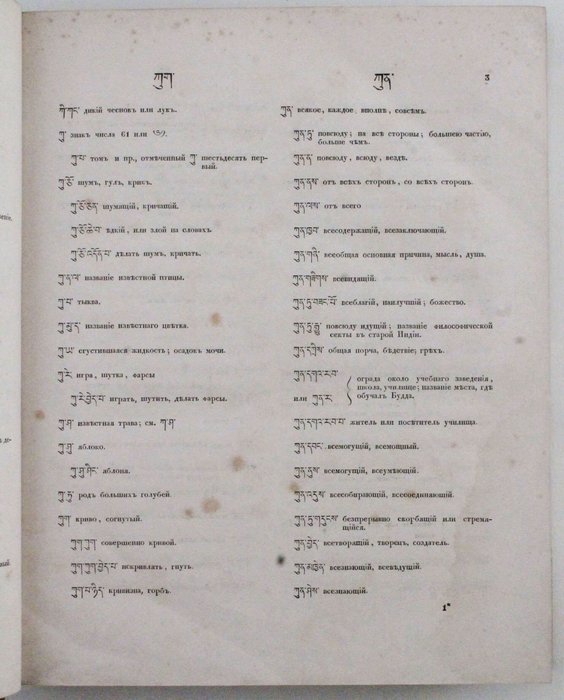

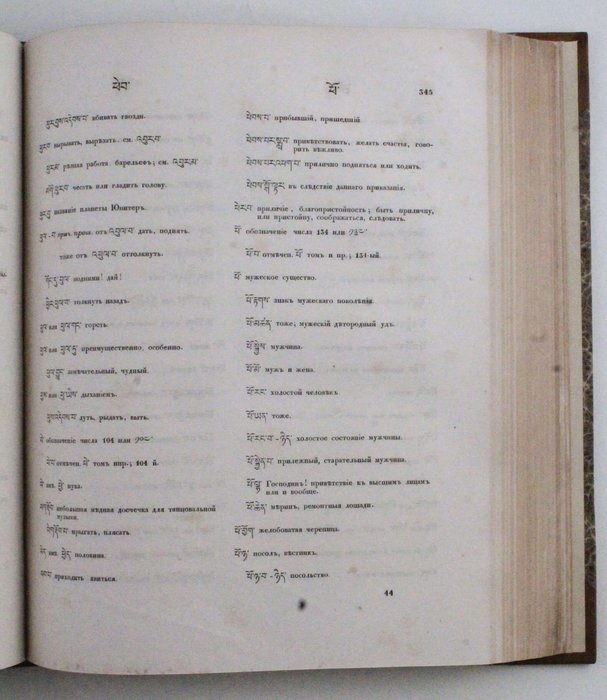
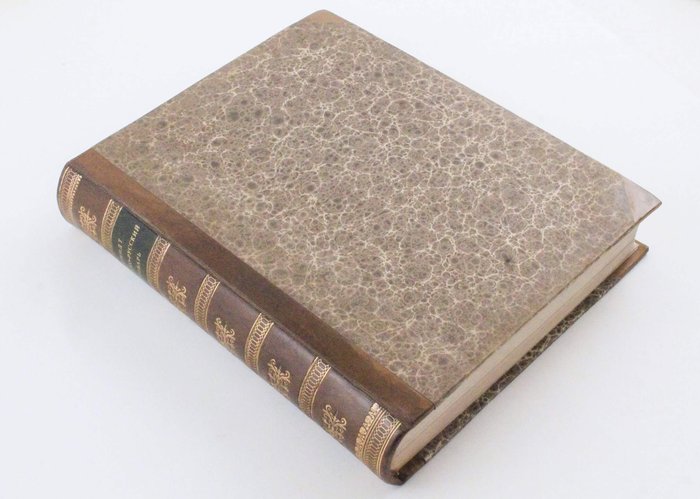
#R75
1843
First and only edition. Folio (ca. 29,5x23,5 cm). [2 – t.p.], [2 – dedication to Minister Sergey Uvarov], [v]-viii, 1-632, [ix]-xi, 633-765 pp. Period style brown half calf with marbled papered boards; spine with gilt-lettered title and gilt-tooled vignettes. Dedication leaf with very minor repair of the right upper blank corner, occasional foxing in text, but overall a very good copy.
Very rare Russian imprint with only six paper copies found in Worldcat (Yale University, University of Wisconsin – Madison, New York Public Library, Thuringian University, National Library of Sweden, National Library of France).
Rare first and only edition of the first Russian-Tibetan dictionary. The book was never republished. The next Tibetan-Russian dictionary was issued only in 1963 (Kratky Tibetsko-Russky Slovar/ Ed. by Y.M. Parfionovich/ Siberian Department of the USSR Academy of Sciences. M., 1963).
The author was Isaak Jacob Schmidt, a noted Russian Orientalist of German origin who specialized in Mongolian and Tibetan languages and literature and introduced the studies of the Mongolian language to European linguistics. “Born in Amsterdam, he spent much of his career in St. Petersburg as a member of the Russian Academy of Sciences. He published the first grammar and dictionary of Mongolian, as well as a grammar and dictionary of Tibetan. He also translated Sanang Sechen's Erdeni-yin tobči into German, and several Geser Khan epics into Russian and German. His works are regarded as ground-breaking for the establishment of Mongolian and Tibetan studies.” (Wikipedia)
As follows from the preface, “Tibetan-Russian dictionary” continued Schmidt’s work, started in his “Grammar of the Tibetan language,” published several years prior (Grammatika Tibetskogo Yazyka. SPb.: Imp. Academy of Sciences, 1839). The dictionary is based on three original Tibetan-Mongolian dictionaries. Comparing his work with the “Essay towards a Dictionary, Tibetan and English” by a noted Hungarian orientalist Sandor Csoma de Kőrös (Calcutta: Baptist Mission Press, 1834), Schmidt noted that his dictionary contained “five thousand new words and expressions,” not found in Csoma de Kőrös’s work (Preface, p. VI). Another advantage of Schmidt’s dictionary was that it became the first linguistic study to list Tibetan words according to the order of their roots, not first characters (Preface, p. VII). This organization closely followed the Tibetan grammar and was later used by other linguists. Schmidt followed the same principles in his Tibetan-German dictionary, published two years earlier (Tibetisch-deutsches Wörterbuch: Nebst Deutschem Wortregister, St. Petersburg – Leipzig, 1841; the facsimile edition was published in Osnabrück in 1969).
Most of the book is the extensive “Tibetan-Russian dictionary” (pp. 1-632). It is followed by a three-page “List [of characters] of the Tibetan alphabet.” About 130 pages (pp. 633-765) are occupied by the alphabetical index of Russian words, helping to find them in the main text of the dictionary. Among others, the list contains geographical and personal names (Allagabad, British Indian, Venus, Vindhya, Gobi, European in India, China, Persia, Russia, Turkestan, &c.) and terms related to Sanskrit, Hinduism, or Buddhism (Anusvara, Achara Tantra, Bodhisattva, Brahma, Vedas, Dalai Lama, &c.). Some words refer to the historical and economic context of Russian life in the 19th century (general-gubernator, desyatnik, karaulny, leib-medik, oberpochtmeister, knyaz, dvoryanin, kaftan, arshin, &c.).
At the end of the Preface, Schmidt promoted his latest study, soon to be published – the translation of “Dsanglun,” a collection of Tibetan folk tales that formed a part of the Kangyur, the Tibetan Buddhist canon. Schmidt’s publication of the original Tibetan text of “Dsanglun” together with its German translation took place later the same year (Dsanglun oder der Weise und der Thor; Aus dem Tibetanischen übersetzt und mit dem Originaltexte herausgegeben. Th. 1: Der Tibetanische Text nebst der Vorrede; Th. 2: Die Übersetzung. St. Petersburg – Leipzig, 1843).
Overall an attractive copy of the rare first Tibetan-Russian dictionary.






